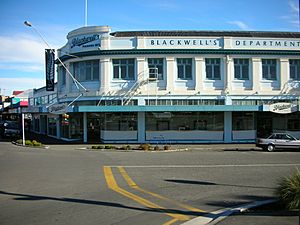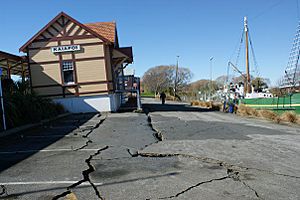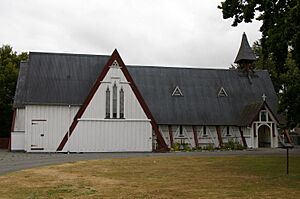Kaiapoi facts for kids
Quick facts for kids
Kaiapoi
|
|
|---|---|

Blackwells in Kaiapoi; demolished after the earthquakes.
|
|
| Country | New Zealand |
| Region | Canterbury |
| Territorial authority | Waimakariri District |
| Ward | Kaiapoi-Woodend Ward |
| Community | Kaiapoi-Tuahiwi Community |
| Electorates |
|
| Area | |
| • Total | 14.65 km2 (5.66 sq mi) |
| Elevation | 3 m (10 ft) |
| Population
(June 2023)
|
|
| • Total | 13,600 |
| • Density | 928/km2 (2,404/sq mi) |
| Local iwi | Ngāi Tahu |
Kaiapoi is a town in the Waimakariri District of the Canterbury region, in the South Island of New Zealand. It's about 17 kilometres north of Christchurch, near where the Waimakariri River meets the sea. Kaiapoi is like a smaller "satellite town" of Christchurch. It's named after the historic Kaiapoi Pā (a fortified Māori village) nearby.
Kaiapoi was badly hit by the 2010 Canterbury earthquake and the 2011 Christchurch earthquake. Many homes and businesses were damaged. Some areas were even marked as "red zones" because the land was too damaged to live on.
Contents
History of Kaiapoi
Early Māori History
Kaiapoi is on land that was once the south bank of the Waimakariri River's north branch. This area was a large island called "Kaiapoi Island." For the Ngāi Tahu people, it was a very special place. They called it Te Rakai a Hewa, which means 'the adornment of the deluded one'.
A stream on the island, Te Tupapaku, was important for traditional Māori burial ceremonies.
European Settlement
In 1849, a surveyor named Charles Torlesse mapped out an area for a new town called 'Mandeville'. This town was meant to help farmers in North Canterbury. However, the group planning the settlement ran out of money, so Mandeville was never built. The area stayed known as 'Kaiapoi' because Māori families still lived there.
Later, in 1851, Sir Thomas Tancred suggested a new settlement called 'Gladstone'. Settlers for Gladstone arrived in 1853, but no land was ready for them. They looked at the mouth of the Waimakariri River. This spot seemed perfect for a new town.
Even though the Gladstone plan didn't work out, the site was so good that work began to establish a town there anyway. By 1854, a small settlement was forming. Many of the original Gladstone settlers made Kaiapoi their home. The first church, St Bartholomew's, opened in 1856. It's still the oldest wooden church in Canterbury today. In 1857, Kaiapoi was officially declared a town.
A Busy River Town
Kaiapoi became a very important place for early settlers in North Canterbury. This was because of its river port. Even though the Waimakariri River could be dangerous for ships, smaller boats could reach Kaiapoi. The port helped transport wool and wheat from local farms to the main port at Lyttelton.
In 1868, a huge storm caused the Waimakariri River to flood. It destroyed buildings, bridges, and the port. Later that year, a tsunami from an earthquake in Peru caused more damage to the wharves.
When the railway line from Christchurch reached Kaiapoi in 1872, the port started to be used less. However, coastal shipping still played a big part in moving goods. The Kaiapoi Woollen Milling Company started in the late 1870s. They made high-quality wool blankets and clothes. This company was a major part of the town's economy until it closed in the 1970s.
During World War I, a large meat processing plant (freezing works) opened in Kaiapoi. It processed sheep from all over North Canterbury and was important to the town's economy until it closed in 1991.
In the 1920s, the town faced more challenges. Earthquakes hit in 1921 and 1922, and a big flood happened in 1923. This led to changes in the river to control flooding. The north branch of the river became less connected to the main Waimakariri River. In 1959, it was renamed the Kaiapoi River.
The port saw a brief return of activity after World War II, bringing in coal and other goods. But by 1969, port activity finally stopped. The town's war memorial remembers 20 local men who died during World War II.
Earthquakes and Recovery

Kaiapoi was severely damaged by the 2010 Canterbury earthquake. Over 900 homes in Kaiapoi and nearby The Pines Beach had to be left because of land damage. The earthquake also broke water pipes and sewerage systems.
Many buildings were damaged and had to be pulled down. The Blackwell's Department Store, a well-known building, was badly damaged and demolished for safety. The Kaiapoi Railway Station building was mostly okay, but its foundation tilted. Instead of being demolished, this historic building was moved to a safer spot and fixed up.
Kaiapoi's Population
Kaiapoi is considered a medium-sized urban area. Its population was about 11,841 people in 2018. After the 2011 earthquakes, the population dropped, but it has been growing quickly since then.
Most people in Kaiapoi are of European background (90.1%). About 11.5% are Māori, and smaller numbers are from Pasifika and Asian backgrounds.
What Kaiapoi is Known For
Kaiapoi is often called the 'River Town' because the Kaiapoi River flows right through its centre. This river was once the main part of the Waimakariri River. However, after many floods, the main flow was moved to the south.
The town was famous for the Kaiapoi Woollen Manufacturing Company. This company made many woollen items that were sold all over the world. A meat processing plant was also a big employer. When both of these closed, the town faced some tough times.
However, Kaiapoi has grown and is now doing well. While some local businesses exist, many people who live in Kaiapoi work in the nearby city of Christchurch. Kaiapoi is seen as a "satellite town" of Christchurch, just like Rolleston.
Education
Kaiapoi has five schools for different age groups:
- Kaiapoi Borough School is a public school for all primary ages. It opened in 1873 and is the oldest school in Kaiapoi.
- Kaiapoi North School is another public primary school. It opened in 1962.
- St Patrick's School is a Catholic primary school that is part of the state system.
- Kaiapoi High School is the public high school for the town. It opened in 1972.
- Karanga Mai Young Parents College is a special unit linked to Kaiapoi High School. It helps young parents continue their education.
Recreation
There are many fun things to do outdoors in Kaiapoi:
- The Kaiapoi River is deep enough for boating. You can even take a ride on a special paddle-boat for tourists.
- The nearby Waimakariri River Regional Park is great for kayaking, fishing, cycling, and off-roading.
- Kaiapoi is also close to The Pines Beach, perfect for a day by the sea.
The Waimakariri District Council runs several public places in Kaiapoi. These include a library, a museum, and a swimming pool. There are also clubs that offer activities for older people and adults with disabilities.
Kaiapoi has rugby teams for both rugby codes:
- The Kaiapoi Rugby Football Club started in 1883. They play at Kaiapoi Park.
- The Kaiapoi Rugby League Club (now called the Northern Bulldogs) began in 1957. They play at Murphy Park.
St Bartholomew's Church in Kaiapoi is the oldest wooden church in the Anglican Diocese of Christchurch. It was built in 1855.
If you like car racing, the Woodford Glen Speedway is just a short drive south of Kaiapoi.
Transport
State Highway 1, a major road, now goes around Kaiapoi. Before 1970, it used to run right through the town's main street. A bus service connects Kaiapoi to Rangiora and central Christchurch.
The Main North Line railway also runs through Kaiapoi. The town used to be a junction for another railway line called the Eyreton Branch, which connected to communities west of Kaiapoi. This branch line closed in 1965. The old Kaiapoi railway station is a historic building.
The Kaiapoi River used to have a busy port. It was important for moving goods to and from Christchurch. The port even reopened for a while between 1958 and 1967. This allowed smaller ships to avoid the busy wharves at Lyttelton. But by 1969, the port finally closed for good.
Notable People
Many interesting people have come from Kaiapoi, including:
- Matiaha Tiramōrehu (?–1881), a leader of the Ngāi Tahu tribe.
- Jane Thomson (1858–1944), a famous mountaineer.
- Stella Henderson (1871–1962), a feminist, university graduate, and journalist.
- Thomas Bavin (1874–1941), who became the Premier of New South Wales in Australia.
- Norman Kirk (1923–1974), who was the mayor of Kaiapoi before becoming the Prime Minister of New Zealand.
- Sisters Erin Baker (born 1961) and Philippa Baker (born 1963), who are well-known New Zealand athletes.
- Matt Todd (born 1988), a rugby player who played for the All Blacks.
At least six All Blacks (New Zealand's national rugby team) were born in Kaiapoi.


